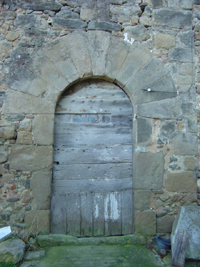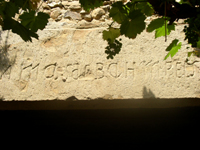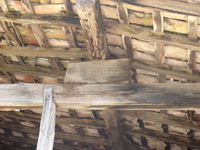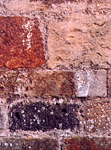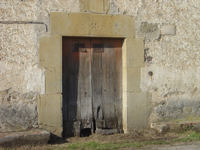la Garrotxa |
les Comes
la Vall d'en Bas (Garrotxa)
Construction complements of the farmhouses in la Garrotxa
The farmhouse enclosures are made from stone combined with mortar in order to achieve greater resistance. The surrounding walls were only clad with cement plaster on large properties where the appearance of the building required a more noble finish that rough stone taken directly from the countryside. Many types of different stone can be found in the different areas of the region such as limestone, basalt, or volcanic rock. The type of stone found on the land is one of the elements that closely links the building to the area and at the same time gives an external overall perception that typifies a determined area.
In la Garrotxa, it is very typical to use A-frames for roofing support especially in porches found close to the farmhouses. This system maintains a determined height using two perpendicular supporting beams separated with a post. This method is often used to build the roofing structure in the farmhouses also. The surrounding land is replete with oak, beech, holms and pine forests as well as olive groves.
A further peculiarity in building techniques to be found in the farmhouses of La Garrotxa is the way in which the rafters in the roof are covered, that is to say, the way in which the tiles are laid. In the rest of Catalunya, the tiles are laid using a technique known as “llata de canal”. However, in La Garrotxa the tiles are laid using a technique called “a salt de garsa”. The technique depends on the layout of the structure of the building. With the method known as “salt de garsa”, the tiles rest at the edges between battens whilst the “llata per canal” method involves placing the tiles between battens in such a way that one row forms the channel for draining the water off the roof and the other forms the ridge. When the roof joists are parallel to the top beam, the system used is that known as “a llata per canal” and on the contrary, when the roof joists are perpendicular to the top beam the tiles are bedded using the method known as “salt de garsa”.Joan Curós i Vilà
Universitat Politècnica de Catalunya
Can Barres
Sant Aniol de Finestres (Garrotxa)
Can Salavia
Mieres (Garrotxa)
el Begudà
Sant Joan les Fonts (Garrotxa)
Can Trona
la Vall d'en Bas (Garrotxa)
